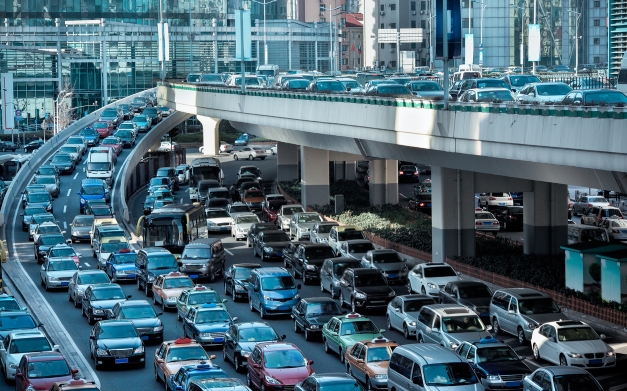Causes of aggressive driving and how to solve it
What causes people to tailgate, speed or run a red light? Read about aggressive driving versus road rage and how to stop it.
By Geotab Team
May 28, 2018
Updated: Mar 27, 2025

As a fleet telematics company that promotes safety and compliance for all of our customers, Geotab helps companies identify aggressive driving and correct the risky behavior, allowing them to increase the safety of their employees while reducing cost and risk within the company. By tracking parameters such as speeding, harsh cornering, and harsh acceleration — to name but a few — fleet managers can begin to detect some of the behaviors that can lead to safety and compliance issues. With this information, managers can provide coaching and feedback to those specific drivers.
See also: Halt harsh braking to improve fleet safety
Aggressive driving vs. road rage
Aggressive driving is not to be mistaken with “road rage.” While road rage can result from driving aggressively, the accepted definition of aggressive driving is a type of intentional driving behavior that puts the driver’s safety and well-being at risk.
Some examples of behaviors that qualify as aggressive driving include:
- Running stop signs or red lights
- Tailgating
- Excessive speeding
- Failure to yield to other drivers when they have the right-of-way
- Weaving in and out of traffic via excessive lane changes, and many others.
Some behaviors that accompany aggressive driving also include horn-honking, flashing lights, yelling, and gesturing at other drivers to display disapproval and annoyance.
In contrast, road rage is defined as an instance of violent and criminal behavior that stems from a traffic altercation where the sole purpose is to harm other drivers. As this article cautions, driving aggressively should not only be avoided because it is dangerous but because it can lead to even more dangerous situations if a driver reacts violently, thus causing a “road rage” event.
What causes people to drive aggressively?
Research studies have found a number of reasons that could influence a driver to exhibit aggressive behaviors. One of the most socially intriguing factors that contributes to aggressive driving is the idea of anonymity. In one NHTSA and American Psychology Association (APA) study, for example, they found that people were more likely to perform acts of aggression in an environment that masked the identity of the perpetrator, such as driving at night or with tinted windows.
The article also describes social factors that are thought to be conducive to aggressive driving include learning such behaviors from parents, peers, and different forms of media like television and movies. It is interesting to note that available research suggests that the majority of people publically do not condone aggressive driving as an acceptable behavior.
A study of six years of data conducted by the AAA Foundation for Traffic Safety discovered a link between increasing commute times and an increase in incidents of road rage.

What can fleet managers do about aggressive driving?
There are a number of telematics-related tools that can support fleet managers in curbing aggressive driving:
- Driver scorecards: Aggregating behavioral data among all your drivers, a driver scorecard ranks drivers by how safe they drive by calculating the number of risky maneuvers they make out on the road. Read more: Do Driver Scorecards Work?
- Gamification: Using driver scorecard information, fleet managers can use gamification processes to incentivize drivers through safe driver recognition award programs, for example. Read more: Motivate Drivers to the Next Level with Fleet Gamification
- Driver feedback: Using driver behavior data in real-time, devices like Geotab GO TALK provide in-vehicle audible warnings and feedback to drivers about their behaviors. Read more: Geotab Interview: GO TALK
- Training and safety education: Using individualized driver behavior data, managers can work create personalized driver training and education so each driver can work on specific habits they need to improve. Read more: 6 Road Crash Statistics You Shouldn’t Ignore
Whether the reasons behind aggressive driving originate from psychological or social factors, like whether or not a person is more prone to aggressive behaviors in general, drivers must learn how to take control and stay calm while driving. One psychologist in this APA study found that relaxation and coping techniques and therapy helped people who were prone to anger improve their driving behavior. This study is also a cue to fleet managers to be considerate of employee stress levels, such as time constraints on routes that can cause drivers to speed in fear of being late.
Read more from these fleet managers about how they use telematics to improve driving behavior.
A concerted effort
The gravity and impact that road safety has on every individual is why we at Geotab continue to do whatever it takes to capture driver data and find new ways to report aggressive driving so it can be identified and corrected. It is also equally important that we all practice defensive and non-aggressive driving techniques to maximize and promote safety on the road and in all aspects of our lives.
Fleet safety requires an ongoing effort. Thankfully, technology can help. Learn more about how Geotab Telematics can help with fleet safety here.
Related:
Subscribe to get industry tips and insights
The Geotab Team write about company news.
Table of Contents
Subscribe to get industry tips and insights
Related posts

.jpg)

Creating a fleet safety culture that’s built to last: Lessons from Missouri DOT and NYC
July 7, 2025
8 minute read

The fleet safety incentive program checklist for driver engagement that lasts
June 19, 2025
2 minute read

Building a self-sustaining school bus driver safety program with Geotab Vitality
June 13, 2025
7 minute read
